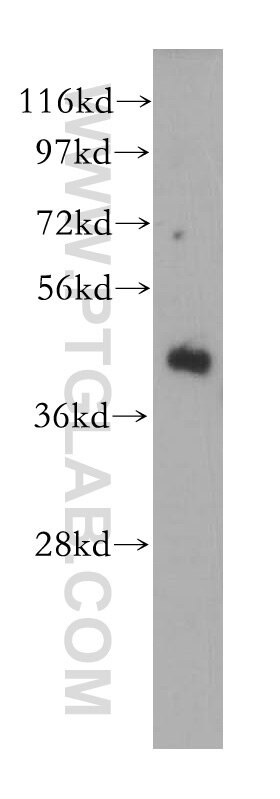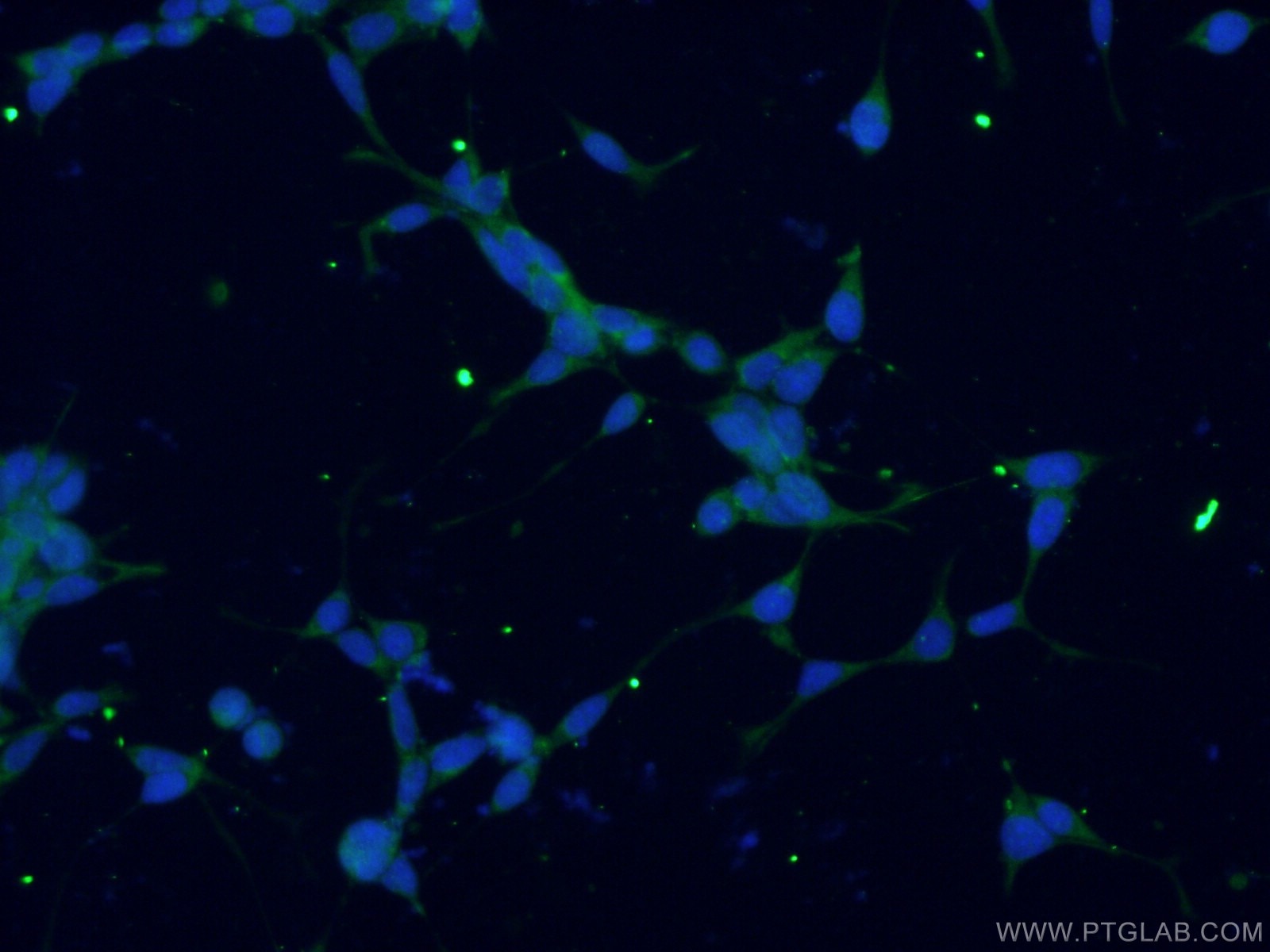Tested Applications
| Positive WB detected in | mouse skeletal muscle tissue, mouse brain tissue, rat skeletal muscle tissue |
| Positive IHC detected in | human ovary cancer tissue Note: suggested antigen retrieval with TE buffer pH 9.0; (*) Alternatively, antigen retrieval may be performed with citrate buffer pH 6.0 |
| Positive IF/ICC detected in | HEK-293 cells |
Recommended dilution
| Application | Dilution |
|---|---|
| Western Blot (WB) | WB : 1:500-1:2000 |
| Immunohistochemistry (IHC) | IHC : 1:50-1:500 |
| Immunofluorescence (IF)/ICC | IF/ICC : 1:50-1:500 |
| It is recommended that this reagent should be titrated in each testing system to obtain optimal results. | |
| Sample-dependent, Check data in validation data gallery. | |
Published Applications
| KD/KO | See 1 publications below |
| WB | See 7 publications below |
| IHC | See 1 publications below |
| IF | See 2 publications below |
Product Information
15094-1-AP targets GMPPB in WB, IHC, IF/ICC, ELISA applications and shows reactivity with human, mouse, rat samples.
| Tested Reactivity | human, mouse, rat |
| Cited Reactivity | human, mouse, zebrafish |
| Host / Isotype | Rabbit / IgG |
| Class | Polyclonal |
| Type | Antibody |
| Immunogen |
CatNo: Ag7168 Product name: Recombinant human GMPPB protein Source: e coli.-derived, PGEX-4T Tag: GST Domain: 1-360 aa of BC001141 Sequence: MKALILVGGYGTRLRPLTLSTPKPLVDFCNKPILLHQVEALAAAGVDHVILAVSYMSQVLEKEMKAQEQRLGIRISMSHEEEPLGTAGPLALARDLLSETADPFFVLNSDVICDFPFQAMVQFHRHHGQEGSILVTKVEEPSKYGVVVCEADTGRIHRFVEKPQVFVSNKINAGMYILSPAVLRRIQLQPTSIEKEVFPIMAKEGQLYAMELQGFWMDIGQPKDFLTGMCLFLQSLRQKQPERLCSGPGIVGNVLVDPSARIGQNCSIGPNVSLGPGVVVEDGVCIRRCTVLRDARIRSHSWLESCIVGWRCRVGQWVRMENVTVLGEDVIVNDELYLNGASVLPHKSIGESVPEPRIIM Predict reactive species |
| Full Name | GDP-mannose pyrophosphorylase B |
| Calculated Molecular Weight | 40 kDa |
| Observed Molecular Weight | 40-43 kDa |
| GenBank Accession Number | BC001141 |
| Gene Symbol | GMPPB |
| Gene ID (NCBI) | 29925 |
| RRID | AB_2111064 |
| Conjugate | Unconjugated |
| Form | Liquid |
| Purification Method | Antigen affinity purification |
| UNIPROT ID | Q9Y5P6 |
| Storage Buffer | PBS with 0.02% sodium azide and 50% glycerol, pH 7.3. |
| Storage Conditions | Store at -20°C. Stable for one year after shipment. Aliquoting is unnecessary for -20oC storage. 20ul sizes contain 0.1% BSA. |
Background Information
GMPPB is a cytoplasmic enzyme that catalyzes the formation of GDP-mannose, a key substrate for several glycosylation pathways, including O-mannosylation of α-DG. GMPPB facilitates the formation of the sugar donor GDP-mannose and pyrophosphate from mannose-1-phosphate and GTP, a very early step in the glycosylation pathway (PMID: 37834154, 27147698). GMPPB mutations correlate with several congenital diseases, including severe congenital muscular dystrophy (CMD) with abnormalities in the brain and eye (PMID: 26310427, 30684953). Western blot analysis detected GMPPB at an apparent molecular mass of 40 kDa.
Protocols
| Product Specific Protocols | |
|---|---|
| IF protocol for GMPPB antibody 15094-1-AP | Download protocol |
| IHC protocol for GMPPB antibody 15094-1-AP | Download protocol |
| WB protocol for GMPPB antibody 15094-1-AP | Download protocol |
| Standard Protocols | |
|---|---|
| Click here to view our Standard Protocols |
Publications
| Species | Application | Title |
|---|---|---|
iScience A Trace Amount of Galactose, a Major Component of Milk Sugar, Allows Maturation of Glycoproteins during Sugar Starvation. | ||
Mol Biomed GMPPB-congenital disorders of glycosylation associate with decreased enzymatic activity of GMPPB. | ||
Front Mol Neurosci Ubiquitination contributes to the regulation of GDP-mannose pyrophosphorylase B activity | ||
Int J Mol Sci Silencing GMPPB Inhibits the Proliferation and Invasion of GBM via Hippo/MMP3 Pathways
| ||
Front Nutr Altered mannose metabolism in chronic stress and depression is rapidly reversed by vitamin B12 |










